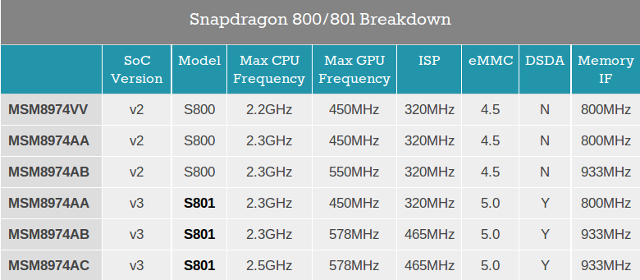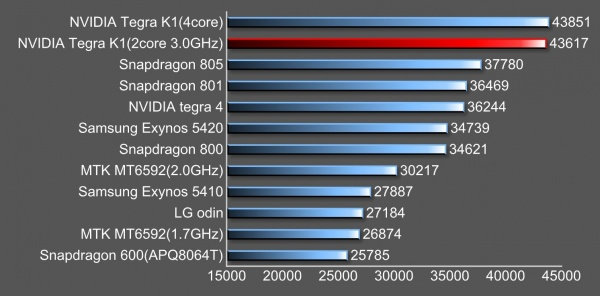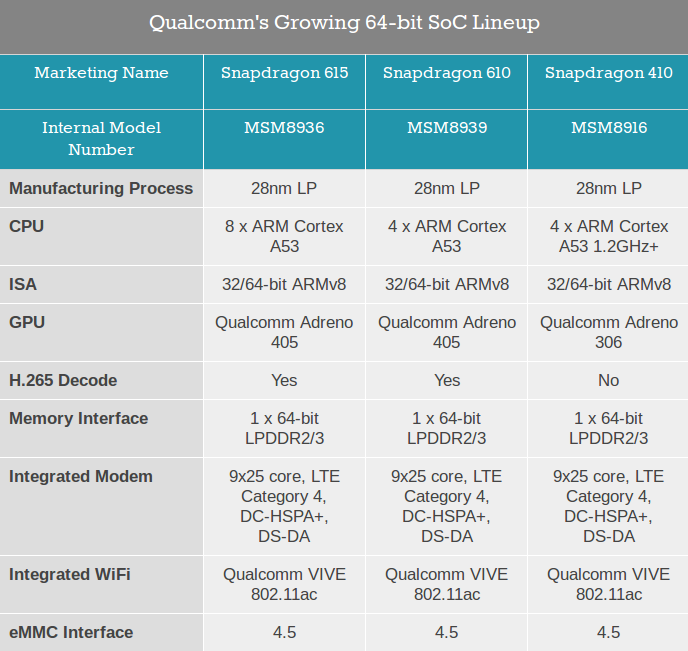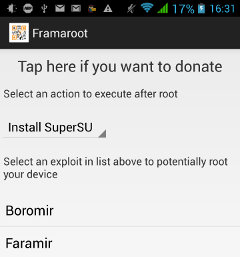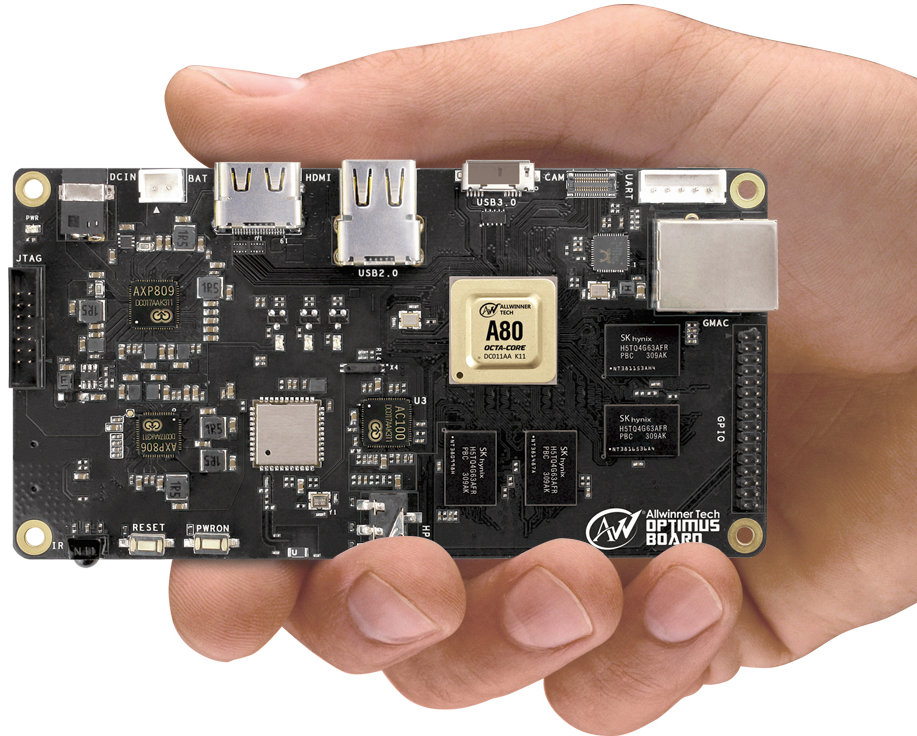Qualcomm usually does a poor job providing details about their SoC when they put out press releases or even in their website. It’s only thanks to a recent post on Anandtech that I’ve found out there are six different versions of Qualcomm Snapdragon 800 & 801. So two devices powered by Snapdragon 800 SoC may not have the same performance, although the differences are minor, I’d still consider this misleading. Snapdragon 801, for instance found in the Galaxy S5 (MSM8974AC), is just a revision (v3) from Snapdragon 800, so all 6 versions are MSM8974 processors, and the differences between models are modifications of the frequency for the CPU, GPU, ISP and memory interface, as well as the eMMC version (4.5 vs 5.0) and support for dual SIM (DSDA = Dual SIM Dual Active). All MSM8974 processors come with four Krait 400 CPU cores, an Adreno 330 GPU, dual ISP, a […]
Nvidia Tegra K1 32-bit and 64-bit Benchmarked with Antutu
Nvidia announced their latest Tegra applications processors at CES 2014 with the Tegra K1 32-bit and 64-bit ARM SoCs, as well as Tegra K1 MVC for automotive application. The 32-bit version comes with four Cortex A15 cores up to 2.3 GHz plus a companion core, and the 64-bit version with 2 ARMv8 cores (Cortex A53?) clocked up to 3 GHz. Both SoC features a 192-core Kepler GPU, and we’ve been shown some high-end graphics demo (OpenGL, OpenGL ES, OpenCL…) with in the reference tablet. Some charts has surface showing both 32- and 64-bit Tegra K1 scoring well over 40,000 and with an excellent 3D graphics score. The benchmark was run in reference platform with 32-bit or 64-bit Tegra K1, as well as the Tegra Note P1761 tablet with a 32-bit quad core Tegra K1 processor apparently clocked at a lower frequency, and with a not-that-good flash. The dual core, 64-bit […]
Linaro Connect Asia 2014 Opening Keynote – Status and Future of ARMv8 Linux & Android [Video]
Linaro Connect Asia 2014 has just started in Macau today and will take place until Friday. You can follow the sessions live and/or their recordings via Linaro OnAir YouTube Channel. I’ve watched the opening keynote, and embedded the video at the bottom of this post. The keynote focuses on ARMv8 for Linux and Android on servers, mobile devices, digital home, and more, and involves two main speakers: George Grey, Linaro CEO , and Jon Masters, Chief ARM Architecture at Red Hat. The speaker beginning of the video provides some practical information and the schedule for Linaro Connect. The keynote itself really starts around 15:50 with George Grey who spends the first 10 minutes introducing the latest Linaro members: Qualcomm, Mediatek, ZTE, AllWinner and Comcast. He then talks about the new Mobile sub-committee (MOBSCOM) that will focus on big.LITTLE, Android optimization and Android on ARMv8, as well as the soon-to-be-announced Linaro […]
Qualcomm Announces Snapdragon 610 and 615 Quad and Octa Core ARM Cortex A53 SoC
MWC 2014 will apparently be the event where 64-bit ARM mobile SoCs are to be announced. After the official launch of Mediatek MT6732, and the soon-to-be-announced Samsung GH7, Qualcomm has unveiled two new ARMv8 processors, namely Snapdragon 610 (MSM8939) and Snapdragon 615 (MSM8936), respectively featuring 4 and 8 ARM Cortex A53 cores and targeting the mid-range of the market. Both processors will be manufactured using 28nm LP process technology, and features the new Adreno 405 GPU with support for OpenGL ES3.0, OpenCL, and DirectX 11.2 support, and up to 2560 x 1600 resolution, support H.265 video decoding, and integrates an LTE category 4 modem, as well as 802.11ac Wi-Fi via Qualcomm VIVE. Anandtech explains that “Snapdragon 615 is made up of two quad-core clusters, each optimized for a different operating point. One cluster is optimized for low power operation while the other cluster is optimized for high performance. This will likely […]
Framaroot is an Android App to Root Mediatek, Qualcomm, Exynos, etc.. Based Devices
Most of the time, when you want to root an Android devices, you may think you have to start your computer, and in many cases, it has to be a PC running Windows, which can be a real pain. Google does not allow apps that provide root access in Google Play, and all you can install are apps that can check whether your device is rooted such as Root Checker. For some reasons, today I needed to root my smartphone (ThL W200, Mediatek MT6589T), and I looked for a method working with Linux, and I did not find any, but I came across Framaroot, an Android app, that allows you to do that within your Android device without external hardware required. Framaroot is very easy to use and support different exploit in order to provide root access to many devices based on Mediatek (Boromir or Faramir exploits), Qualcomm (Gandalf exploit), […]
Qualcomm QPrize Competition Targets Innovative Startups with Wireless Devices or Apps
Qualcomm Venture, Qualcomm’s venture investment arm, has recently announced the launch of QPrize 2014. QPrize is a seed investment competition designed to provide entrepreneurs their first level of funding so they can launch their idea into a successful start-up business. The competition is open for residents of 7 “regions”: China, Europe, India, Israel, Korea, Latin America and North America. However, China QPrize is apparently a separate event, and it may be too late for this year. You’ll have to submit your business plan to Qualcomm by April 18, 2014 (no NDA allowed), and the company will then select finalists for each region which will compete in regional finals (dates and venues to be defined0, with the winner getting $100,000. The 7 regional winners will compete during the Grand Finals which are scheduled to take place at the Bloomberg Next Big Thing Summit event, June 9-10, 2014 in Sausalito, CA, with the […]
Media Player SoCs at CES 2014 – Qualcomm Snapdragon 802 and Sigma Designs SMP8756
Apart from Nvidia Tegra K1, CES 2014 has been somewhat disappointing when it comes to new mobile SoCs announcement. On the media processor front, we’ve had Marvell announces Skyworth Android TV set-top boxes and HDTV based on their ARMADA 1500 Plus SoC, and we’ve got at least two new processors for media players with Qualcomm Snapdragon 802, and Sigma Designs SMP8756. Let’s have a look at some of the details. Qualcomm Snapdragon 802 Qualcomm has started to enter the media player space with MPQ8064 / 8064M last year, but I haven’t seen actual products based on this SoC, except Qubi, which is not shipping yet. This year, the company announced Snapdragon 802 SoC designed for next-generation smart TVs, smart set-top boxes and smart digital media adapters. As usual, the company gave very little details in the press release, but here’s what we know: Quad core Krait processor @ 1.8Ghz with […]
What to Expect from AllWinner, Rockchip, Mediatek, and Other Silicon Vendors at CES 2014
CES 2014 is coming soon, and it will take place on 7 – 10 January, 2014, and we can expect some interesting SoC news. Samsung suggested they will unveil their 64-bit ARM SoC (Exynos 6?) at CES 2014, Nvidia will hold a press conference to “showcase new NVIDIA Tegra mobile technologies, gaming innovations, and advanced automotive display technologies”, and Qualcomm has been quiet for now. However, several Chinese SoC vendors, namely AllWinner, Rockchip, and Mediatek, have already announced what they will showcase at CES 2014, albeit with few details. AllWinner at CES 2014 Allwinner announced will showcase their OptimusBoard based on their Ultra Octa-Core A80 SoC, as well as 4G tablets powered by Allwinner A31/A31s, and dual-SIM phablets sporting A23 dual-core. Allwinner A80 is an Octacore processor featuring four ARM Cortex A7 cores, and four Cortex A15 cores @ 2.0GHz together with an unnamed GPU offering 2x more performance over previous […]


